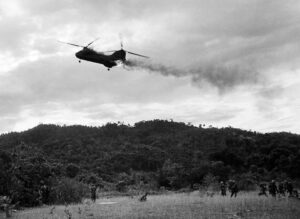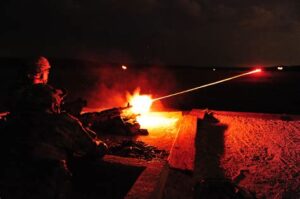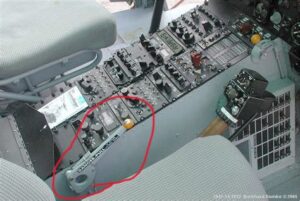
Five months in-country now, the last three months bouncing back and forth between Chu Lai, DaNang, and Quang Tri. It’s the beginning of March 1969 and the wet monsoon season is behind us. Returning to the Rattler AO (area of operations) from the CCN (Command and Control North) Special Operations missions into Laos has been a pleasant reprieve. Virtually no recent enemy activity in the 196th AO during the monsoon season. The area is quiet.
An early evening flight from Chu Lai Rattler base camp to the Firebird’s forward operating base at Landing Zone Baldy finds us following the Thien Phuc river westward from Tam Ky into the 196th AO and eventually to LZ Baldy for the night. The two helicopter ‘light’ fire team is flying at a safe altitude to reduce the threat of small arms enemy groundfire. Tonight, I am flying in the ‘lead’ ship of the two-ship fire team with Lloyd Gfeller, Firebird 92 (Fatbird). As flights go, this one is proving to be very routine with good weather and clear flying visibility. Small-talk radio chatter converses over crew intercom and with our ‘trail’ gunbird.
Fatbird is flying the lead as we continue over the river and sandbars beneath us. It is a lazy evening flight. Suddenly the intense staccato throbbing of heavy ground fire breaks our reverie and both door gunners immediately ‘open up’ to return fire. Turning backward and looking across my right shoulder through the open right-side crew door, I see a bright cherry red light arcing upward towards our aircraft. The bright red ‘light’ sails upward in slow motion from the tree-lined riverbank. Quickly calculating the arc geometry, I realize it’s flying straight for my head!

Although time seems to ‘freeze’ for a few moments with the realization that this projectile is heading straight towards me – that moment shatters when the .51cal. projectile impacts the right side of the helicopter. The gunship shudders and I watch the ‘bullet’ deflect off the right gun mount and fly out in front of the aircraft, forever lost in space. A glancing blow struck off our right side and out into space – and I had witnessed the entire episode. The impact and jolt to the helicopter felt incredible. It seemed to shift the aircraft sideward in flight.
The aircraft instantly yaws to the left. Glancing at Fatbird I can see he is busy ‘on the controls’ fighting to fly the aircraft. THAT noise now? A loud roaring noise? I turn rearward, press the floor mounted radio switch and call over the intercom – ‘Bruce?’ ‘Yes sir,’ replied Specialist 5 Joe Bruce the gunship crew chief and door gunner. ‘Are we on fire?’ I ask. ‘Yes sir!’ is his quick reply. The round had penetrated the soft metal skin of the right rocket pod and ignited the solid propellant fuel in the nineteen rockets loaded with almost 200 lbs. of highly explosive TNT.

I reached down to the center pedestal and pulled upward on the yellow painted jettison handle. The jettison handle is a release mechanism designed to allow the pilot to manually drop or ‘dump’ the mounted stores. It works great IF the jettison release cables are connected to the onboard aircraft jettison mechanism – unknown at the time, the right cable had been severed by the impacting round rendering the jettison mechanism inoperative.
As I pulled up on the lever, I watched the left side rocket pod release and fall away toward the river. Unfortunately for us the burning rocket pod was still attached to the aircraft mount. The radio came to life with a call from the fireteam wingman, ’92, are you alright? It looks like you’re on fire!’ The white-hot flames from the rocket propellant were streaming down the right side of the helicopter past the tail rotor. A giant white fiery plume was flowing from the rocket pod and the added ‘propulsion’ of the rockets kept pushing the helicopter to the left.
‘Bruce!’ I yelled at the intercom. ‘Yes sir?’ he replied. ‘Get rid of that rocket pod!’ I yelled. ‘YES SIR!’ came his response. Joe Bruce laid his M-60 machine gun on the aircraft floor and incredibly I watched as he crawled out the right crew door. His ‘monkey harness’ fastened to an aircraft tie-down ring allowed him about three feet of free movement. Half inside and half outside the flying gunship, Joe reached down and grabbed the flailing jettison release cable with his right hand. As he steadied himself with his left hand on his seat rail he kicked and kicked and kicked away at the still burning rocket pod. Finally, the damn thing fell away.
All this took place in less than a minute because there isn’t much time to linger when 19 rockets are on fire with the exciting possibility of 200 pounds of TNT exploding at any second. Or better yet, the entire right side of the helicopter aluminum & magnesium tail boom skin catching fire and falling off in-flight. No better Hollywood midair explosion than this!
While Joe and me are having our little tete-a-tete, Fatbird is diving the aircraft toward the river. Maybe we’ll splash in the water to extinguish the fire? Wonder how it feels swimming with a 10,000 lb. helicopter strapped to my back? But he’s preparing to land just in case. As we near the river and the aircraft slows slightly, our wingman confirms the burning pod is away and it appears all is well with our aircraft. Just as well for us, no way do we want to land or remain in this area after taking fire (and a huge hit) from the close by 12.7-mm anti-aircraft gun.
‘92’ adds power, pulls up on the collective pitch control and off we fly to LZ Baldy minus two fully loaded rocket pods. Circling upward over the sandbar I spot the dropped and dented left-side rocket pod partially buried in the sand. I wonder if ‘Charlie’ will find it and retrieve the rockets only to use them against us – a question without an answer.
Twenty-five years later as I waited for lunch at a Helicopter Association International exhibition, I spot Joe Bruce. He looked the same although now he sported a dark beard and mustache. I remarked to my colleague about the burning rocket pod incident and told him that I had to speak with Joe. With no introduction, I approached Joe and began relating the events of our flight. He looked at me very suspiciously (obviously, I didn’t look the same as 25 years before!).
On and on I rambled about that evening’s events while flying over the Thien Phuc River, discussing the heavy anti-aircraft fire, the burning rocket pod, and Joe’s successful dance of determination to drop the fiery pod. Bewildered he finally he asked me: ‘WHO are YOU?!’ When I told him who I was he couldn’t believe it – couldn’t believe after all the years and all the miles that we would again meet and relive those harrowing moments. We shook hands and hugged and had a few good laughs. We reminisced about that event and our by gone days as young sky warriors doing astonishing things in a bizarre war.
‘What a guy!’ Joe Bruce, the crew chief extraordinaire` who gave his all that night. Standing on the gun mount in the open air outside our flying helicopter attached only by his ‘monkey harness’ doing his dance of determination on a flaming can of 200 lbs. of high explosive with 40 feet of fire flaming down the right side of the helicopter. Thanks, Joe! The crew survived that day because of you. We owe our lives to you! ‘What a Soldier!’
2019 – update: Joe was posthumously awarded the Distinguished Flying Cross for his actions. I successfully lobbied and submitted his DFC recommendation through Congressman Roger Williams’ Cleburne, Texas office. After almost two years in the Army’s review process, Joe’s DFC was approved in August 2019. Unfortunately, Joe passed away in January 2018.

(c) Copyright – 2023 Vic Bandini